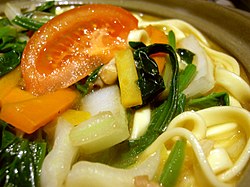Thukpa
This article needs additional citations for verification. (March 2017) |
 | |
| Type | Soup |
|---|---|
| Region or state | Tibet and Indian subcontient |
| Associated cuisine | India, Nepal |
Thukpa is a Tibetan noodle soup, which originated in the eastern part of Tibet, eastern and northern part of Nepal and Northeast India. Amdo thukpa (especially thenthuk) is a famous variant among Tibetan people and himalayan people of Nepal. The dish became popular in various parts of Nepal, Bhutan, and the states of Sikkim, Assam, Nagaland and Arunachal Pradesh in northeast India. It is also popular in the Ladakh region and the state of Himachal Pradesh. The food is widely available in these regions. The numerous varieties of thukpa in Tibetan tradition include:
- Thenthuk (Tibetan: འཐེན་ཐུག་, Wylie: 'then thug): Hand pulled noodle
- Gyathuk (Tibetan: རྒྱ་ཐུག་, Wylie: rgya thug): Chinese noodle
- Nepali (Nepali: थुक्पा)
- Pathug (Tibetan: བག་ཐུག་, Wylie: bag thug): Hand rolled pinched noodle (like gnocchi)
- Drethug (Tibetan: འབྲས་ཐུག་, Wylie: 'bras thug)
Etymology
Thukpa has been described as a "generic Tibetan word for any soup or stew combined with noodles."[1]

Nepalese thukpa
The Nepalese version of thukpa contains chili powder, masala (usually garam masala), which gives it a hot and spicy flavor. It is considered as one of the Indo-Tibetan food, having great influence both from Tibet (noodles/soup) and from the Indian subcontinent (Indian spices/garam masala).
Gallery
See also
References
- ^ Boi, L.G.; Ltd, M.C.I.P. (2014). Asian Noodles. EBL-Schweitzer. Marshall Cavendish. p. 163. ISBN 978-981-4634-98-4.


